Backpacking in Denmark
Surely a backpacker adventure in Denmark cannot be compared to a backpack trip through Southeast Asia or South America. But why should you do that? If you want to discover Denmark, you can look forward to a very special, unique backpacker experience. The country on the northern border to Germany not only captivates with an efficient public tourist structure, but also with numerous travel highlights, which you can’t discover anywhere else on the globe.
Look forward to many geographical facets with few people on the trip through Dansk. Roughly speaking you can expect countless worth seeing museums of all kinds, spectacular festivals, a sometimes old architecture, adventure possibilities on land, on water and in the air and many cultural peculiarities of the locals. You will encounter medieval flair in many cities as well as pure nature in the various national parks. Do an island hopping (there are over 400 of them) with ferries or sailing boats, get to know the fantastic forests or cliffs at the North Sea and the Baltic Sea or discover the culture of the Vikings with numerous relics.
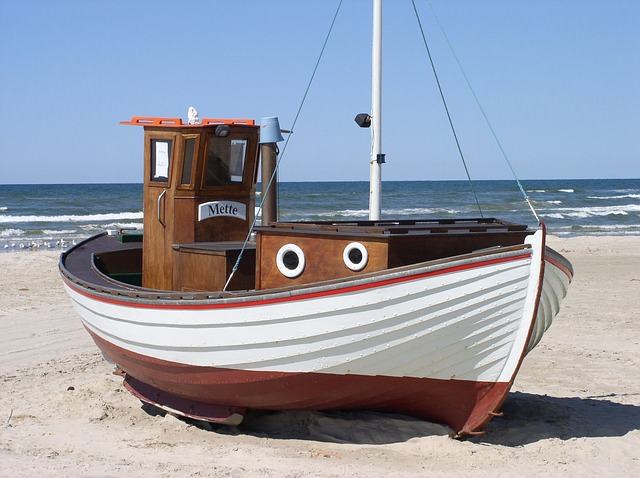
Denmark Fisher Boat
Mountaineers can safely leave their equipment at home. The highest peak reaches just 170 m. But the wind blows even stronger all year round.
When backpacking through the country, you can choose from a wide range of accommodation options, from cottages and campsites to hostels, hotels and more. You should take care of your budget, because one thing is for sure, travelling is not cheap. Whether you’re eating out or buying something to eat in a supermarket, you don’t have to worry about prices like in Southeast Asia or Eastern Europe.
You can explore the country by train or by bus, which connects the villages with each other. Those who have plenty of time can walk or cycle. You get the most out of the country when you rent a car. That doesn’t have to be for the whole tour. It’s also worth it for 2-3 days. Who wants to get to know all Denmark highlights on a tour, travels the whole 3500 km long Marguerite route. On the way you will certainly get to know some of the many culinary delights, including Tuborg or Faxe beer.
You don’t have to worry about the cash supply. There are ATMs in every town where you can use the most common credit cards. A little off the beaten track, you may encounter some comprehension problems, but there’s usually always someone who speaks English and German.
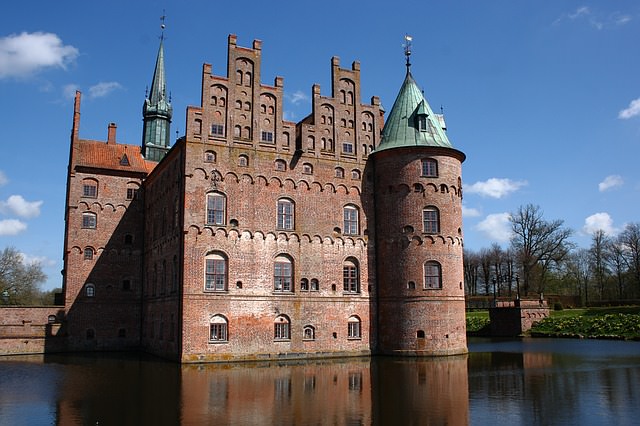
Denmark Fyn Castle
Culture in Denmark
There are only about 5.6 million Danes spread over an area of 42.916 km2. This also means that you can undertake your backpacker tour undisturbed by partly uninhabited areas. A hospitable people awaits you, but they have their peculiarities. Respect for your counterpart is always called for. You will encounter a rather ancient culture that has undergone many changes over the centuries.
The population is 95% Protestant-Lutheran. You hardly know Siezen at all. All are with each other by you. Exceptions are older persons and the queen. Remember that you are not allowed to smoke in most public areas. But you should cycle, because that is something like the national people’s movement. But it has little to do with sport.
An important term, which you should know, is “Hygge”. The word has the meaning of cosiness, community and security. So you know what is important to the Danes. Except football perhaps. By the way, the Faroe Islands and Greenland also belong to Denmark, although they administer themselves. There the cultural customs are again somewhat different from the Danish ones.
More Backpacker information about Denmark
Denmark is not a backpacker country like you know it from Asia or South America. But backpacker tours are also possible over a longer period of time for the small budget. During the high season, the prices for overnight stays and supplies can increase considerably. Between 35 and 70 euros per day should be enough to see the most interesting Denmark highlights including admissions and to make ends meet. Take advantage of the savings offers on national Denmark travel and transport sites. Avoid the tourist spots in high season. You can consume cheaper in side streets and in the country.
Denmark has a lot to offer backpackers in terms of adventure and culture. Whether on foot, by bike, by train, by boat or whatever. Depending on the season, take the right backpacker clothes with you. The wind is blowing everywhere. Adventure awaits you in and on the water, in the cities, on the land and when touring.
Denmark is and has never been a cheap travel destination. Those who travel during the peak travel season sometimes have to dig deep into their pockets. Especially the alcohol has its prices. Stay away from the absolute tourist highlights in summer. Better you backpack through the country in the low season.
Denmark also has a lot to offer from a culinary point of view. Strong meat dishes and hearty vegetable meals, but also light and tasty fish dishes and sweet treats plus good beer can be found in every Danish region.
On your backpacker adventure trip through Denmark, you’ll discover some strange Danish customs and traditions. What these are and what you should have seen, plus some worthwhile secret tips about Denmark can be found below.
As a German citizen you will have no problems entering Denmark. Make sure that your identity documents are valid. There are no problems with tropical infectious diseases. In Denmark you will find first class medical care.
Backpacker Budget in Denmark
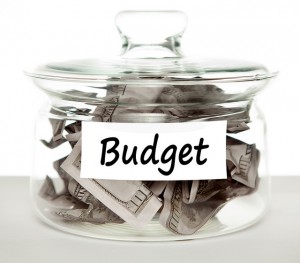
Budget in Denmark
Traveling and living in Denmark is anything but cheap. That doesn’t mean that you can’t make it on the backpacker trip for a good price. Knowing how is the motto. It is especially important to look for internal offers on the relevant domestic travel pages.
Sometimes there are museum passes or you travel after or before the main season, when the prices for overnight stays and meals in the tourist places are still quite low. For example, get the Copenhagen Card, which gives you reduced admission to more than 74 sights > copenhagencard.de.
Included are also a free transport by train, bus and metro in the Danish capital. Some visitor highlights are free anyway, among them the Copenhagen Tours, which start every day at 11 am at the city hall. You can find more free offers at copenhagen.com.
The cost of living is higher than in Germany. So that you get times an idea, which cost such a few products in Denmark in usual shops: Local beer 0.5 litres 5,37 euro, import beer 0.33 l bottle 4,70 euro, a Cappuccino 4,35 euro and a Coke/Pepsi 0,33 l approx. 2,69 euro.
Costs for the bus
The average price for a bus ticket is 3.22 Euro. With the Copenhagen Pass you can travel for free, but only in the capital. With the taxi it starts from 5 Euro and then you have to add about 2 Euro per driven kilometer. If you want to backpack by bus, have a look at rejseplanen.dk, which is available in German and English. You can find out everything about prices and routes.
Costs for domestic flights
Domestic flights are not worthwhile for backpackers. But if you have to, then check out the websites of the airlines SAS Scandinavian Airlines System, Norwegian and DAT for offers. For example, there are flights from Copenhagen to Aalborg. Such a flight can cost between 30 Euro and 80 Euro. Often taxi costs are added to the airport costs.
Costs for the train
A train trip is on average much cheaper than a flight if you include all travel and departure costs. You can find out which rail routes there are in Denmark and what the prices are for all classes at de.rail.cc on the homepage.
If you want to take one of the many ferries to the different islands, you can get information at faergen.de, fjordfaehren.de or daenemark-faehren.de.
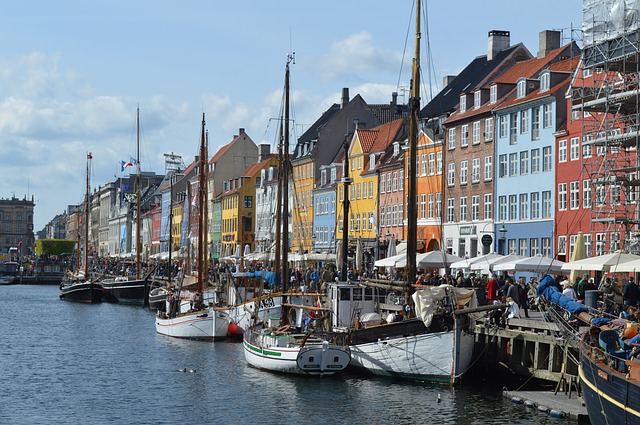
Backpacking in Denmark
Backpacker Route in Denmark
Right from the start, there are no real backpacker routes in Denmark, as tourism is tailored to the needs of other travel groups. However, as camping is very important in Denmark, it is easy to combine different places to go. Like other tourists, it is best to take the so-called Marguerite Route, where you can see almost all the sights of the country. But you have to take some time, because the route is over 3,500 kilometers through the country.
And it goes partly far down from the main roads. It’s easy to explore because all the highlights are signposted thanks to a perfect infrastructure. You will cross a breathtaking natural landscape, pass old farmhouses, magnificent manor houses as well as fashionable castles and quaint national parks. The best way to explore the route is by bike or rental car. On the route you can do all kinds of water sports. Let’s have a look at the Denmark Highlights for Backpackers.
Route 1: The Classic
- 3- 5 days exploring the capital Copenhagen with its museums and shopping streets plus the landmark of the statue of the Little Mermaid
- 3-5 days Danish South Seas, with the islands Zealand and Funen
- 3-5 days North Sea and Skagerrak
- 1 day Aalborg at the Limfjord with the Aalborg Castle
- 1 day Hirtshals with the largest seawater aquarium in Europe
- 1 day Ribe with the well preserved Old Town
- 1 day Møn with the chalk coast Møns Klint
Route 2: Backpacker Intensive Trip (up to 40 days and more)
- 3- 5 days exploring the capital Copenhagen with its museums and shopping streets plus the landmark of the statue of the Little Mermaid
- 3-5 days Danish South Seas, with the islands Zealand and Funen
- 3-5 days North Sea and Skagerrak
- 1 day Aalborg at the Limfjord with the Aalborg Castle
- 1 day Hirtshals with the largest seawater aquarium in Europe
- 1 day Ribe with the well preserved Old Town
- 1 day Møn with the chalk coast Møns Klint
- 2 days Wadden Sea islands Fanø and Rømø in the North Sea
- One week island jumping from Bornholm to Langeland, Lolland and Lyø. The latter with some of Denmark’s most attractive villages.
- 1 day Jelling with its rune stones, which are part of the world cultural heritage.
- 1 day exploring Odense, the birthplace of the poet Hans Christian Andersen
- 1 day to see the world famous Roskilde Cathedral
Travel times in Denmark
There are no specific travel times that you should consider when backpacking. Winter has as many advantages as summer. You can’t expect tropical temperatures even in summer on your backpacker tour. Be ready for the Skai, a dry, cool sea breeze that blows in spring or the Havguse, a thick wall of fog that appears in the summer months. As a small hint to the general weather situation in Copenhagen. Half the year it pours, snows or hails there. But in summer it can get up to 30 degrees and more over a short period of time.
Backpacker accommodations in Denmark
What about the hostels and the prices for an overnight stay? It is generally assumed that a backpacker trip through Denmark is quite cost-intensive. This does not have to be the case, however, as there are alternatives that can reduce the costs, especially in terms of accommodation costs.
Travel out of season, stay overnight in backpacker hotels, consider an apartment exchange for a longer stay at a location, check out island tent camps (www.oelejr.dk) or save on special overnight deals.
You can save money by sleeping in hostels that you can find in Copenhagen’s Norrebro district. But beware! Some are only open in summer. Another advantage is a Danhostel Annual Pass, which is valid for all houses of the chain in the whole country and helps you to get discounts. Otherwise always pay attention to the action programs on the hostel pages.
Calculate with overnight prices starting from 17 euro in a Dorm in Copenhagen and in Arhus. Concerning the exchange of flats, you can have a look at the pages how:
- bbdk.dk/byt
- intervac.dk
- boligbytte.com
You can also save on the cost of work. Or you can work against a bed on an organic farm. Find out more at wwoof.dk. With a bit of hard work you can secure a free bed for yourself. It couldn’t be cheaper.
Camping in Denmark
Camping is one of the main pleasures of the Danes. And that’s good for you on your backpacker trip through the country. Because you can choose from thousands of campsites in all categories and price ranges. 750 of them are very simple and inexpensive. And they are also located in some of the most beautiful places in the country. If there’s too much stormy weather, you can rent a cheap shelter at the campsites.
You can also do this if you don’t have a tent with you. Information about the places at campingfuehrer.adac.de. However, it may be that you need a camping pass. You can buy or order the pass at the office of your first campsite, at the local tourist offices or at the Danish Camping Union (Dansk Camping Union). Find out more about Danish camping sites here.
Backpacker Trips, Tips & Highlights in Denmark
In the backpacker adventure through Denmark you will not only get to know the varied geography, although there are no real mountains. You will also meet a hospitable people and an ancient culture with a real Viking flair. There is no mention of the cool, reserved people in the north, because the Danes are quite open-hearted and approach their guests. The best way to discover the country is by bike, car, bus or hitchhiking.
Without a vehicle it gets tough, because the distances between the places and sights are partly big because of the relatively thin settlement. Choose between a trip along the Danish North Sea coast or the Baltic Sea coast or simply do both. No matter where you start from Germany, in the middle you always get to North Jutland, the tip of Denmark between the North Sea and the Baltic Sea.
While in West Jutland you meet the dunes on the Danish North Sea coast, in East Jutland you pass the inviting Danish islands of Samsö and Anholt. If you like the rich flora and fauna of the Wadden Sea, then take a detour to South Jutland on the Baltic Sea. North Zealand is known as the Danish Riviera. Bornholm, on the other hand, is called the pearl of the Baltic Sea.
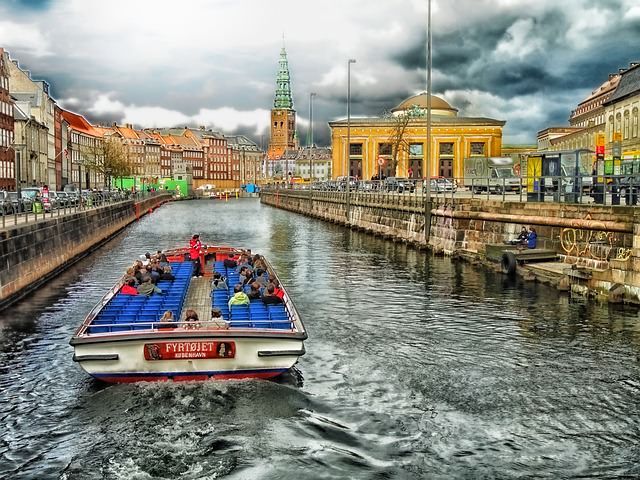
Denmark copenhagen
Backpacker Highlights
One of the backpacker highlights in Denmark, if not the ultimate backpack highlight, is the Marguerite Rod in Denmark. Once you’ve taken it off, you should have seen the most important 1000 Danish sights. However you should take some time for it, because the distance is 3,500 km long.
And it doesn’t always go only over well paved main roads, but partly far into the interior off the highways. Running off would certainly be a variant. But then we plan a few months for it. Brown-white-yellow signs with the well-known flower on them show you the way. A map and directions are also available as an app at visitdenmark.de.
Backpacker insider tips
There are no real insider tips for backpackers in Denmark, as the country is completely developed for tourism. Nevertheless, some routes are frequented by a few. Surely the island hopping is a special backpacker fun. There is no lack of islands. On more than 400 North Sea and Baltic Sea islands you can get to know the country and its people. Have a look at the Baltic islands South Zealand, Lolland, Falster and Møn. Or you can go to the fairytale island of Funen. It gets really wild in the South Fyn Archipelago, where numerous inhabited and uninhabited islands line up.
The International Viking Market in Ribe, which takes place from 2 to 8 May, is certainly a real highlight. Fascinating is also a sunset at the Stevns Klingt and in the Parforcejagdlandschaft in North Zealand. Or go to the Danish end of the world at the “end of the world”, where the North Sea and Baltic Sea meet. The 15-kilometre-long cliff between the towns of Lonstrup and Lokken runs almost 90 metres above sea level. And if you can’t do without mountains or hills, you have to go to Mols Bjerge.
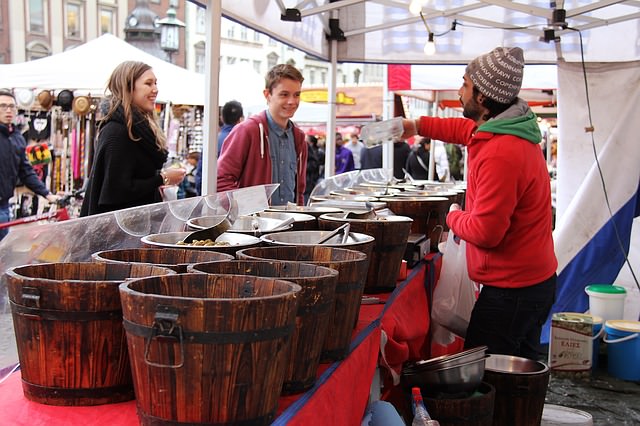
Backpacking in Denmark – Market
Food & Drinks in Denmark
When baking in Denmark you can look forward to a traditional, nutritious and delicious local cuisine. Not necessarily only light fish dishes, despite the proximity to the two seas, are on the menu. Also due to the intensive agriculture, meat dishes and vegetable dishes can be found during a culinary foray through the country.
Eating out isn’t as expensive as is generally claimed, by the way. Sure, you shouldn’t eat in the tourist strongholds in the fully occupied Touri restaurants. In most cases you’ll be excluded from them. Look for the small hidden restaurants, especially far out in the small villages, in order to try the local cuisine. Also in the cafeterias the dishes are often quite cheap.
All about food
The most important meal in Denmark is the Middag or Aftensmad meal, which is eaten by the family in the evening if possible. The Danish basic cuisine is based on dairy products, fish and meat dishes of all kinds. There are also various bakery and bread products. Well known are dansk bøf and Smörrebröd next to stegt flæsk og persillesovs. While the first and third are meat dishes, Smörrebröd is probably the best known Nordic type of bread in Germany.
The Danes use the bread as a full-fledged lunch dish, but only when the wholemeal bread slices are heavily topped. Also popular are the local hot dogs and French fries, which are eaten individually or as a side dish. The Danish national dish is not a fish or seafood dish made from herring, plaice, eel or other types of fish, as one might assume, but a roast pork cooked slowly in the oven. Another treat is the Danish Labskaus variant Skipperlabskov.
If you order honningkager, wienerbrød or kransekage, then your palate can look forward to a sweet fireworks of taste.
You can also find the world-famous fast food chains in all the larger towns, but why not try the local cuisine? If you go out to eat, then you don’t have to give a tip, because this is included in the prices. This is probably the reason why some prices seem so high.
What can you drink there?
If you are a wine lover, you have a bad hand in Denmark. The Danes serve a good beer or a strong schnapps at or after the meal. Danish beers like Carlsberg, Tuborg, Faxe and other beers are also well known in Germany. The Aquavite like the Aalborg Akvavit are genuine throat cleaners. However, alcoholic beverages are not inexpensive.
Backpacker Visa and Vaccinations in Denmark
Denmark is part of the EU. As a German citizen you don’t normally have any problems at the border crossing, even if Denmark wants to introduce stricter entry controls due to the refugee crisis. But make sure during your backpacker trip in Denmark that your identity papers are complete and up to date. Due to the refugee problem it can come to short-term changes in the entry permit again and again. Keep yourself informed about the current situation on pages such as the website of the Federal Foreign Office.
According to the Federal Foreign Office, you will need the following entry documents in order to enter Denmark without any problems. German citizens can enter Denmark if they are in possession of the following documents:
- Passport: Yes
- Provisional passport: Yes
- Identity card: Yes
- Temporary identity card: Yes, must be valid.
- Children’s passport: Yes
- Still valid child ID according to old model: Yes
- Also important: Every child needs his or her own ID document.
Visa
As a German citizen you do not need a special visa for Denmark, as Denmark is an EU country.
Medical Information & Vaccinations
Due to its geographical location, Denmark does not have to contend with tropical diseases and viruses. In case of an illness or travel accident you can hope for good medical help all over Denmark. Remember that your vaccination card is complete and up to date.
